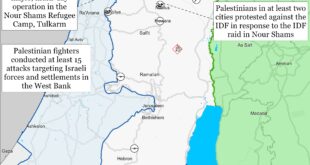Long denied by Western allies, Ukraine has received a new long-range missile system from the United Kingdom, which is working with the Netherlands to procure F-16s on Ukraine’s behalf.
The Storm Shadow cruise missile’s 300-kilometer range enables Ukraine to strike deep into Russian-controlled territory, placing the Russian Black Sea fleet’s Crimean headquarters and some Russian cities near the border within striking distance.
Claims over Russia’s illegally annexed territories in Ukraine, combined with its nuclear saber-rattling, risk a severe response should Ukraine targe these areas with long-range missiles.
Russia is reportedly expanding its partnership with its Middle Eastern ally Iran to build a drone manufacturing plant in Russia to produce more lethal models.
In a watershed moment for Ukraine’s military capabilities, the country received a long-range missile system from the United Kingdom capable of striking deep into Russian-controlled territory. The Storm Shadow cruise missiles can strike targets approximately 300 kilometers, or just under 190 miles, from their launch point. The initial delivery of Storm Shadow cruise missiles coincides with intensified fighting in the city of Bakhmut, as Ukraine’s deputy defense minister announced on May 18 that Ukrainian forces had recaptured the southwestern part of the territory and were mounting an encirclement of Russian forces in the city, while Wagner Group head Yevgeny Prigozhin said his fighters had seized the city. Ukrainian President Zelensky denied Prigozhin’s claim. All of this, however, suggests a long-awaited Ukrainian counteroffensive may soon be at hand. Speaking at the G7 Summit in Hiroshima, Japan, Ukrainian President Volodymyr Zelensky spoke about the dystopian destruction in Bakhmut, ravaged by Wagner Group mercenaries and other Russian forces. Zelensky thanked allied countries for their support and stressed the need for more weapons and equipment. Less than a week after news broke that the United Kingdom would supply Ukraine with its first long-range missiles, reports surfaced on May 15 that Storm Shadows were already striking the Russian-occupied city of Luhansk. Russia’s defense ministry and pro-Russian separatists in Luhansk claimed that the missiles had already struck two industrial facilities in the city three days earlier, though the Institute for the Study of War said available visual evidence did not support that claim.
The delivery of the Storm Shadow missiles marks the first time such a long-range weapons system has been provided to Ukraine since the war began. The United States and other European allies had thus far denied Ukrainian requests for long-range missiles, as well as for fighter jets like the American F-16. Yet developments last week signaled that the West may be relaxing one of its last remaining holdouts against Ukrainian aid requests. Three days after the U.K. and the Netherlands announced they were building a coalition of governments to support the procurement of F-16s and other forms of air combat assistance for Ukraine, the New York Times reported on May 19 that the United States would support the training of Ukrainian pilots to use the fighter jet. Still, any country hoping to transfer U.S.-made fighter jets in their possession must first obtain a re-export license, a request the Biden administration has not yet granted. With the training announcement, however, it is likely only a matter of time until this hurdle is cleared, as well.
In part, Western refusal to provide long-range missiles has been predicated on the fear that Ukraine might strike beyond Russian-occupied Ukrainian territory and into Russia itself, substantially escalating the conflict. To assuage these concerns, U.K. defense minister Ben Wallace assured that the missiles would only be directed towards Russian-occupied areas that are considered sovereign Ukrainian territory. This still seems to leave the possibility, however, that the missiles might be used to target disputed territories like Crimea, which Russia illegally annexed in 2014, well before the full-scale Russian invasion in 2022. Some analysts have speculated that an attack on Crimea or the four Ukrainian regions illegally annexed by Russia in September could be construed by Russian President Vladimir Putin as an attack on the Russian Federation itself, sparking fears that he could, in a worst-case scenario, respond by deploying tactical nuclear weapons under the guise of self-defense.
The Storm Shadow’s expansive range means the headquarters of the Russian Black Sea fleet, housed in the Crimean city of Sevastopol, now appears to be within firing range of Ukrainian-held territory, as are several Russian cities near Ukraine’s northeast border. However, such risky targets may not be necessary for Ukraine to disrupt its opponent’s military capabilities. An adviser to the Ukrainian defense minister has suggested the Storm Shadows would be used to target Russian assets such as fuel and ammunition depots as well as command centers located “on the temporarily occupied Ukrainian territory.” Deep missile strikes beyond Russia’s frontlines could also free up defensive forces in the rear to open lanes for Ukrainian assaults.
In addition to receiving hundreds of Storm Shadows as well as various drone systems from the United Kingdom in the coming months, other European partners have pledged to bolster their military support for Ukraine. Germany has promised nearly $3 billion in additional military assets, including Leopard tanks and other ground combat vehicles, Howitzer artillery systems, air defense systems, and more. The new German aid package is valued at nearly double the country’s total prior contributions to Ukraine’s war effort. France has also promised more armored vehicles and light tanks.
For its part, Russia is expanding its drone cooperation with Iran, with the two countries planning to establish a production facility in Russia capable of producing some six thousand additional drones in the years ahead. So far, Russia has received approximately 400 drones from Iran to use against Ukraine, and it is currently looking for “a more capable and more lethal” version to use in the future, according to U.S. National Security Council spokesperson John Kirby. Russia has used explosive drones to attack Ukrainian critical infrastructure and specifically target cultural heritage sites, at least 1,600 in number, including monuments and memorials, museums, and places of worship. Such attacks are meant not only to cripple Ukraine’s ability to operate and provide basic necessities to its citizens but also to obliterate Ukrainian identity through the destruction of its history and culture. Ukraine has proven adept at shooting down the slower-moving Shahed-136 drones currently available to Russia, especially now that it possesses two top-tier Patriot air defense systems to replace its legacy Soviet systems. The new drone plant is expected to produce a faster, longer-range version of the Shahed-136 that may pose a greater challenge to Ukrainian air defenses. Russia has already launched nine attacks on Kyiv this month, including an exceptionally large missile volley on May 16. The attack reportedly damaged one of Ukraine’s Patriot systems; according to U.S. officials, the damage to the system was minimal and it remains operational.
 Eurasia Press & News
Eurasia Press & News




